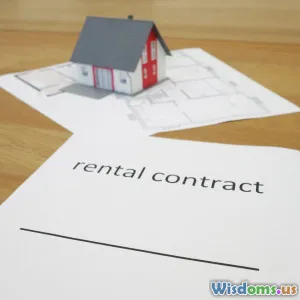
Lessons Learned From My Worst Property Investment Ever
15 min read Discover crucial lessons from a failed property investment, and learn strategies to avoid costly real estate mistakes in your own investment journey. (0 Reviews)
Lessons Learned From My Worst Property Investment Ever
Every successful investor has a story about their worst decision—a deal where things didn't just go wrong, but seemed to spiral at every turn. For novice real estate investors, hearing these stories can be more valuable than any "how-to" guide because they're packed with practical lessons and reality checks you won't find in glossy marketing brochures. Today, I'd like to offer a brutally honest account of my own property investment disaster, breaking down where I failed, what I missed, and the hard-won insights I now apply to every deal. Whether you're considering your first rental property or an experienced investor, these lessons are a sobering reminder: in real estate, education never ends.
Chasing Hype Instead of Fundamentals

When I decided to invest in an up-and-coming urban neighborhood, it was largely based on buzz heard at real estate meetups and through online forums. Everywhere I turned, people were touting "the next big thing"—promising capital gains as the area was being "discovered" by trendy cafés and new condo developments. It was easy to get swept up by the excitement and FOMO.
The Mistake: I prioritized hype over facts. I neglected to ask critical questions: Are job opportunities in the area increasing? What's the crime trend? Is there real, sustainable demand for rentals or buyers, or just short-term investor speculation?
What Happened: Within a year of my purchase, several planned developments were put on indefinite hold when city funding dried up. The "neighborhood transformation" stalled, crime began rising, and tenants became harder to attract. My property value flatlined while property taxes crept up, turning projected "equity growth" into a myth.
Takeaway: Don’t mistake anecdotes for economic indicators. Research local employment rates, school ratings, long-term development plans, and demographic trends. Use the numbers, not narratives, to justify an investment.
Overestimating My Own Skill—and Underestimating Renovation Costs

Inspired by success stories on social media, I purchased a fixer-upper with the belief that I could manage repairs and upgrades for a fraction of the cost that other people paid contractors. After all, how hard could it be to paint, replace tiles, or fix a leaky faucet?
The Reality Check: Even the most straightforward renovation project can balloon out of control—especially when old infrastructure hides outdated wiring, corroded plumbing, or structural issues. My pet project turned into months of sleepless nights, spiraling budgets, and mounting frustration.
Concrete Example: My $12,000 budget for repairs quickly doubled after I misdiagnosed a "minor" plumbing issue that needed a professional re-pipe job. DIY errors meant tear-outs and re-dos, particularly with tiling and shower installations. I lost prospective tenants—and income—while the property remained unrented for an additional 5 months, compounding interest payments.
Tip: Always overestimate your renovation budget—by 30% at a minimum. Accept what you don’t know; professional contractors (though expensive) prevent costly mistakes. Do a complete inspection (roof, foundation, electrical, plumbing) before you close, and avoid properties with "investor special" labels unless you have substantial contractor relationships and contingency funds.
Underappreciating the Importance of Location Dynamics

"Location, location, location" is the real estate cliché—and for good reason. However, understanding a neighborhood’s momentum requires more than believing in gentrification.
Where I Went Wrong: I failed to consider how adjacent areas (not just the property’s block) would impact the future value. While my property sat on a seemingly pleasant street, a major thoroughfare two blocks away brought in transient activity and pollution. Noise complaints skyrocketed, and my tenants constantly complained about car break-ins and late-night activity.
Practical Advice: Don't just visit a property during sunny afternoon showings. Walk the area at night, talk to existing residents, and check police blotter maps online. Evaluate school ratings, walk scores, and public transport accessibility. Understand community engagement: Are there strong neighborhood organizations? Are problems being addressed or skirted over in city council meetings?
Long-term View: Some locations only seem to be improving; have backup data (not just projections) that supports real change. Remember that convenience and safety trump speculation.
Overleveraging and Ignoring Cash Flow Realities

When deals are hot, it's tempting to stretch finances thin, thinking "rents will rise" or "I'll refinance before any balloon payments come due." This optimism blinded me to fundamental cash flow analysis.
My Financing Mistake: Encouraged by glossy loan brochures (promising great "creative financing"), I overleveraged, putting just 5% down with a high LTV loan. I convinced myself that rental income would cover not just the mortgage, but taxes, insurance, and repairs—all while turning a healthy profit.
Harsh Lesson: My first tenant moved out unexpectedly. Vacancies lasted longer than I budgeted, and property taxes rose sharply just as a local jobs report highlighted layoffs. Suddenly, "positive cash flow" was negative—even worse during renovation delays. I missed two mortgage payments, risking damage to my credit.
Best Practices: Only invest if property rents cover your FULL true costs—including vacancies, repairs, management, and debt payments—with a buffer. Use conservative estimates for both rents and costs; be wary of "projected appreciation" as your crutch. Limit leverage until you have experience and robust reserves.
Dismissing Professional Property Management

Many rookie investors try to "save money" by managing their rentals directly. I assumed I could find tenants, screen them effectively, collect rent, and handle (minor) maintenance—all while working a full-time job.
Where It Fell Apart: My "screening process" was cursory—checking pay stubs and references from friends. I accepted the first applicant who passed the minimums. I underestimated the time required for repairs, communication, and late-night emergencies. I also missed new regulations about rental housing in my municipality.
Consequences: The tenant failed to pay rent after three months, leading to a costly and time-consuming eviction. During their short stay, extensive property damage occurred—neglected by my sporadic attempts to check in. Legal fees and turnover costs evaporated the meager profits from prior months.
Actionable Insight: Professional management is not merely a cost, but a shield. Vet firms by interviewing them, asking for references, and checking their tenant screening procedures. Unless you can invest full-time, outsourcing this work can prevent emotionally and financially draining mistakes.
Neglecting Legal Due Diligence and Insurance Details

This investment underscored the significance of legal and insurance safeguards. In my haste, I skimmed the property’s title report and insured the building based propositionally, without considering liability or potential natural disaster coverage.
Problem Uncovered: After a minor electrical fire, my insurance claim was delayed because the policy did not cover outdated electrical systems. I had also failed to properly transfer an expired city rental permit, unknowingly violating local ordinances. When neighbors complained about my absentee status, fines accrued rapidly.
Hard-earned Lesson: Always perform a thorough title search and don't skip over the "fine print" in insurance. Meet with a real estate attorney—preferably one with local investment experience. Review all local municipal requirements for rental homes, from lead paint disclosures to yearly inspections. Insurance should consider replacement cost, liability, loss of rent, and appropriate disaster coverage. These seem like afterthoughts—until disaster strikes.
Realizing the Value of Mentorship and Community

In the rush to prove myself, I tried to figure everything out solo—brushing off offers of advice or partnership. I viewed mentorship as a sign of weakness rather than the asset it clearly is.
What I Changed: After my disaster, I joined several local real estate investor associations and online groups. Sharing my experience not only helped me process the loss, but opened doors to advice about new investment markets, contractor referrals, and even off-market deals.
Real World Example: One senior investor explained precise strategies for vetting neighborhoods—right down to evaluating sewer lines and researching city planning meetings. Another shared template spreadsheets for deal analysis, offering peer review before purchase.
Why It Matters: Real estate is a team sport. Lean on mentors, attorneys, inspectors, property managers, and your investing network. With their insights, you’ll avoid rookie mistakes and compound your success.
Understanding When to Walk Away, and How to Exit Strategically

Often, cutting losses is the wisest decision—even if it bruises your pride.
My Struggle: I clung to my property, hoping for a market uptick, trying out various rent discounts and quick-fix upgrades. All the while, my monthly losses mounted. When I finally decided to sell, so many shortcut repairs and compliance issues scared buyers away, resulting in a lower sale price.
Better Approach: Set predetermined criteria for cutting losses—if negative cash flow extends past 12 months, or if repairs exceed X% of the property’s value. Have an exit strategy before you buy: Will you rent, flip, or sell wholesale to another investor?
Negotiate with honesty and document your repair history. Even a loss can be managed smartly if you’re prepared.
How to Recover and Invest Smarter Next Time

Despite my frustrations, the experience became the bedrock of my investing philosophy. Here’s what I do differently today:
- Rigorous Due Diligence: Detailed inspections, conservative financial modeling, and third-party rent comps are nonnegotiable.
- Professional Input: I consult with accountants, property managers, and legal experts before offers.
- Reserve Funds: Every deal includes at least six months’ worth of reserves—for both personal living expenses and property-specific costs.
- Community Involvement: Continued education through investor meetups, mentorship, and real estate forums keeps me alert to market shifts.
- Objective Evaluations: Emotion is parked at the door. If a deal doesn’t meet strict cash flow and location benchmarks, I pass—no FOMO, no regrets.
No loss is pleasant, but every misstep sharpened my process. Today, my real estate portfolio is smaller, but far healthier, diversified, and stress-tested. I encourage every investor, new or seasoned, to reflect on their own failures and absorb the underlying lessons. Disasters make you humble but, done right, they’ll never make you poor again.
Rate the Post
User Reviews
Popular Posts


















